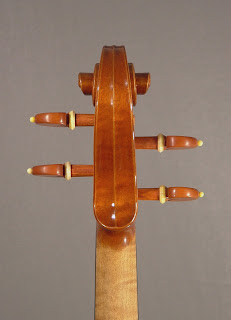Bassbar clamps.
There are never enough clamps in the workshop. They are expensive sometimes and they can be hard to find.
For glueing bassbars, I have basically used two kinds of clamps. Keeping in mind that the requirements for these are lightness and fast action, I have two wooden "forks" that I use to secure the bar in its position as fast as I can. These are the well-known, traditional ones. The other clamps are simply cut off from a 3/4" birchwood plywood board and provided with a screw made of brass (metric 6mm or 6MA threaded bar + wing nut, glued or brazed -- UNC 1/4" x 20 would be ideal). There is no need to provide a swiveling foot, for which a lathe would be necessary; the slightly pointed tip simply makes its way into the soft wood (light action required!) and the imprint can also be used to retrieve the correct position after a dry run. An aluminum nut is inserted on one side and a simple cork pad is glued to the other arm.
Lately, I have found some brass nuts used in construction (for assembling drywall or something like
that) that have a nice knurled surface.
Wooden plane for preparing rib stock.
This is the plane that I use for the task of rib thicknessing. The toothed iron (I believe it is a IBEX iron that I was able to buy on a rare convenience sale) is seated at about 45°, bevel down, and a plate makes for a very small mouth opening on its front. In this way, the plane action is very smooth and there is almost no tearout on difficult grain.
For the brass plate, I have used some offcuts from a material that is normally made into brass doorbell plates. It is a very "dry" brass alloy, similar to bronze.
For the plane body, I have used my beloved Australian hardwood and some African mahogany for the wedge (which also makes for a handle). The body is an assembly of four pieces and the wedge is secured in place with a brass rod. I have countersunk the plate but this is not strictly necessary, I believe that epoxy glue is just enough.
Finger planes.
Making luthier's finger planes is not hard if you know how to work and braze copper and brass alloy.
Bronze would be ideal but, it's much harder to shape. Copper could be too tender and the plane may become scratched and dented over time although being functional. I have made a prototype plane out of copper and I have been using it for more than 10 years.
After making the prototype, basically I selected a brass piping leftover from some construction work and cut a small section from it, that has been bent in an almost oval shape, but not like IBEX's, mine are more like a rectangle with rounded ends. I used a vise and a simple wooden counterform to do that.
This shape allows seating the blade at about a 40° angle. I believe this is a good compromise in order for the plane to work smoothly on spruce and maple as well.
The prototype has a toothed blade.
The sole curvature is critical. Too much and you will have a plane that leaves very deep hollow marks which will take a lot of work to smooth out with the scraper. Too little and you won't be able to work into the difficult sections of the arching where the curvature radius changes fast.
Here are some pictures. I plan to make some more planes in the following weeks and I'll see if I can make a small video tutorial on my method.



























































